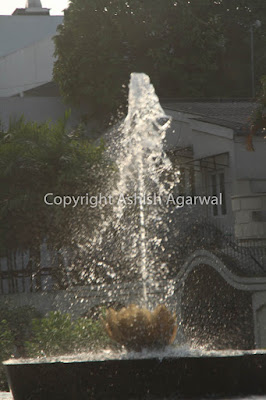Sunlight Through Water: The Magical Dance of a Fountain
Sunlight Through Water: The Magical Dance of a Fountain
A fountain stands quietly in the heart of a city garden, framed by leafy trees and modern buildings.
At its center, a jet of water soars upwards, scattering into thousands of shimmering droplets.
The sun filters through this liquid veil, catching and bending light into tiny flashes—almost like stars falling in slow motion.
This is not just a fountain.
It is a dance.
A meeting point between two of nature’s purest elements: water and light.
The Silent Language of Light
Light is the invisible hand that paints everything we see.
Without it, color would not exist. Texture would be hidden. Movement would lose its sparkle.
When sunlight strikes water, something magical happens.
-
It refracts, bending into rainbows.
-
It reflects, scattering glints in every direction.
-
It transforms the familiar into the extraordinary.
In the image, the sunlight pierces the soaring water column, breaking it into millions of sparkling fragments.
Each droplet becomes a tiny lens, catching the day’s golden warmth and tossing it into the air.
It’s a reminder that light, though invisible on its own, reveals the hidden beauty of the world around us—especially when it meets the ever-changing form of water.
The Beauty of Water Flow: From Laminar to Turbulent
When we look at a fountain, we’re also witnessing the physics of water flow.
-
Laminar Flow:
When water moves smoothly in parallel layers, it creates a clear, glass-like stream. In some high-end fountains, you’ll see single arcs of perfect clarity, bending without breaking. -
Turbulent Flow:
When water rushes and collides, swirling unpredictably, it forms sprays, bubbles, and froth. This is the flow we see in most traditional fountains, like the one in the image. -
Spray and Mist:
Some fountains use fine nozzles to break water into mist, creating dreamy, cloud-like effects that sparkle in the sun.
In this fountain, the water leaps upward in a near-turbulent surge, then cascades into spray.
It is this mixture of movement—strong yet scattered—that catches the sunlight so vividly.
Fountains Before Electricity: A Testament to Ingenuity
Long before motors and pumps, fountains were feats of pure human ingenuity.
Ancient civilizations—like those in Mesopotamia, Egypt, and Greece—built fountains that operated solely through gravity:
-
Water was collected from distant sources (rivers, springs) located at a higher elevation.
-
It was channeled through aqueducts and pipes.
-
The natural force of gravity created enough pressure to send water upwards when it reached a fountain basin.
The famous fountains of Rome, like those in the Villa d’Este and Piazza Navona, were powered entirely by carefully engineered hydraulic systems.
No pumps. No wires. Just water, height, and smart design.
These early fountains were not just decorative; they were practical sources of drinking water and cooling relief in hot climates.
And yet, even then, humans could not resist making them beautiful—adding sculpture, carving basins from marble, turning necessity into poetry.
Fountains in the Modern World: Where Art Meets Engineering
Today, fountains have evolved dramatically.
-
Electric Pumps: Powerful motors circulate water continuously, making fountains independent of elevation or natural flow.
-
Programmable Displays: Modern fountains can now synchronize jets, lights, and even music into elaborate shows (think Bellagio Fountains in Las Vegas).
-
Recycling Systems: Water is recaptured in underground reservoirs and re-circulated, reducing wastage.
-
Eco-Friendly Designs: Newer fountains integrate solar panels and rainwater harvesting.
Yet, even with all this technology, the essence remains unchanged:
A fountain is a celebration of water’s beauty, framed by human imagination.
The one in this image, with sunlight piercing its jet, captures this spirit perfectly—a marriage of simplicity and wonder.
Why We Are Drawn to Water and Light
There is something deeply primal about our fascination with water and light.
-
Water sustains life. It cools, cleanses, and nourishes. Its movement soothes us, its sound calms our minds.
-
Light brings clarity. It energizes us. It inspires creativity and optimism.
When the two combine—as in the burst of a sunlit fountain—they stir something wordless inside us.
Something ancient. Something joyful.
It is why children run laughing through fountains in summer.
Why photographers wait hours for the perfect shot of water caught mid-sparkle.
Why, even in busy cities, people pause—if only for a second—to watch a fountain dance.
In an image like this, the light isn’t just highlighting the water.
It’s revealing the magic that is always there, hidden in the ordinary, waiting for a spark.
The Fountain: An Abstract Sculpture in Motion
For lovers of abstract art and imagery, a fountain offers endless beauty.
-
The random paths of the water droplets create natural, ever-changing patterns.
-
The sunlight fractures and dances differently each second, depending on angle, time of day, and season.
-
The shapes formed—arcs, sprays, spheres—remind us of galaxies, firework bursts, or seeds scattering in the wind.
In a way, a fountain is both sculpture and painter, canvas and brush.
It exists in a state of constant creation and dissolution—each moment unique, each moment fleeting.
Just like life itself.
Closing Reflection
This photograph captures more than just a fountain in motion.
It captures a story—a timeless meeting of earth’s two great gifts: light and water.
In its spray and sparkle, we see history and future.
We see ancient ingenuity and modern mastery.
We see the pure, universal joy of simple elements dancing freely.
And perhaps, most importantly, we are reminded to pause.
To look.
To let the sunlight catch in our own lives—sparkling, fleeting, precious.
Because beauty is everywhere.
Sometimes, it’s just waiting for the right light to reveal it.
Want to get tips for improving your photography ? Get Photo Tips from this blog.

 RSS
RSS

0 comments:
Post a Comment